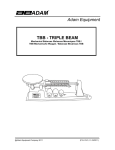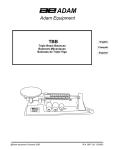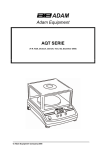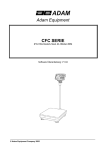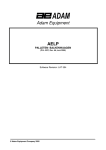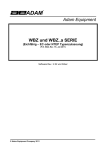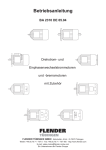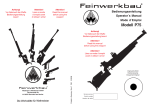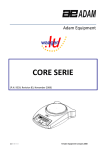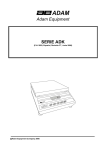Download Adam Equipment 2610T User's Manual
Transcript
Adam Equipment TBB - TRIPLE BEAM Mechanical Balances /Balances Mécaniques TBB / TBB Mechanische Waagen / Balanzas Mecánicas TBB @Adam Equipment Company 2007 (P.N. 8141, B4- 02/2007) @Adam Equipment Company 2007 2 (P.N. 8141, B4- 02/2007) CONTENTS ENGLISH 1.1 INTRODUCTION.......................................................................................................4 1.2 SETTING UP ............................................................................................................4 1.3 WEIGHING ...............................................................................................................5 1.4 FILLING TO A KNOWN WEIGHT .............................................................................5 1.5 DENSITY DETERMINATION ....................................................................................5 FRENCH 2.1 INTRODUCCIÓN ......................................................................................................7 2.2 INSTALLATION.........................................................................................................7 2.3 PESAGE ...................................................................................................................8 2.4 REMPLISSAGE JUSQU’A UN POIDS CONNU........................................................8 2.5 DÉTERMINATION DE DENSITÉ ..............................................................................8 GERMAN 3.1 EINFÜHRUNG ........................................................................................................10 3.2 AUFSTELLEN .........................................................................................................10 3.3 WIEGEN .................................................................................................................11 3.4 AUF SOLLWERT AUFFÜLLEN ..............................................................................11 3.5 DICHTEBESTIMMUNG ..........................................................................................11 SPANISH 4.1 INTRODUCTION.....................................................................................................13 4.2 AJUSTE ..................................................................................................................13 4.3 PESAJE ..................................................................................................................14 4.4 LLENANDO A UN PESO CONOCIDO....................................................................14 4.5 DETERMINACIÓN DE LA DENSIDAD ...................................................................14 @Adam Equipment Company 2007 (P.N. 8141, B4- 02/2007) 1.1 INTRODUCTION The TBB 2610S and TBB 2610T are Single Pan Balances of unequal arm type with 3 beams. They are often referred to as Triple Beam Balances. The maximum capacity is 2610g with the supplied counter weights. Both the models come complete with counter weights (3) for weighing up to 2610 grams above the basic capacity. The TBB 2610T has an additional counter weight beam for Tare of up to 225 grams other than weighing up to 2610 grams. 1.2 SETTING UP • Unpack carefully. The balance consists of the main body and 3 auxiliary counter weights (2 each for 1kg loads, 1 for 500g load). Note that the counter weights are not 1kg or 500g masses. They are used only to balance this amount of mass. • Place on a firm, level surface away from fans or open windows. Remove the rubber bumper from under the pan support. Slide all the weights to the left. Make sure the 2 largest weights fit into the notches on their beams. The front weight should point to zero. • To lock the TBB down using the optional Security lock, insert the locking mechanism into the hole marked on the base of the TBB model. Follow the instructions supplied with the lock and wrap the cable around a fixed object. Make sure the cable does not hit the beams or the hanging weights. • Check the zero. The pointer on the right end of the beam should align with the zero mark. Adjust the thumb screw on the left end of the beam, if necessary. Capacity Tare Readability Beam Calibration: Damping Protractor Ruler Lock Down Device Density Determination 2610 grams with counter weights +225 g on TBB 2610T only 0.1 g Beam Range Increment Front 0-10 g 0.1 g Beam 2nd Beam 0-500 g 100 g 10 g 3rd Beam 0-100 g Magnetic 3 Inches ( " ) & centimetres (cm) Uses Security Lock 3 152 mm (6") diameter Stainless Steel 505 x 110 x 160 mm (20" x 4.3" x 6.3") 2.7 kg (5.94 lb.) Pan Size Overall Size (w x h x d) Net weight English @Adam Equipment Company 2007 4 (P.N. 8141, B4- 02/2007) 1.3 WEIGHING To weigh using the TBB 2610 place the item to be weighed on the stainless steel pan. The beam will move up. Adjust the weights on the 3 beams until the beam pointer is aligned with the zero mark again. Start with the largest weight and work towards the smallest. Each weight should be moved until the beam falls below zero then moved back one notch and then the next weight moved. The last weight moved will be the sliding weight on the front beam. Slide this weight until the beam pointer aligns with the zero mark. Read the weight by adding the values for each weight. For example 400+20+5.7 = 425.7g If the sample is more than 610 grams it will be necessary to add a weight to the hanger on the right side of the beam. Add the 500g counter weight first then increase to 1kg, 1kg plus 500g or 2 of the 1kg masses. Add these counter masses to the readings from the sliding beams to determine the mass. USING A CONTAINER FOR THE SAMPLE, WITH THE TBB 2610S BALANCE If an empty beaker is placed on the scale you must first determine the weight of the empty beaker. Then add the material to the beaker and weigh again. The weight of the material within the beaker is the total weight minus the weight of the beaker when empty. USING A CONTAINER FOR THE SAMPLE, WITH THE TBB 2610T BALANCE The tare mass on the back of the beam can be used to counteract the weight of the empty container, up to 225 grams. Set all the weights to show zero on the beams. When the empty beaker is placed on the scale slide the tare mass along the rod until the beam pointer is aligned with the zero mark. Then add the material to the beaker and weigh as normal. The weight of the material within the beaker is the weight being shown by the sliding weights. 1.4 FILLING TO A KNOWN WEIGHT Place the empty beaker on the balance and determine the weight or zero the scale (TBB 2610T). Add the desired weight to this value to determine the final weight. Set the weights on the beam to represent this final value. Pour the material into the beaker slowly. As the desired weight is approached, the beam will rise. Stop filling when the beam pointer is aligned with the zero mark. 1.5 DENSITY DETERMINATION The TBB series balances are supplied as standard with three legs allowing the balance to be raised about 185mm (7”) above the surface. There is also a small hook attached to the bottom of the TBB’s weighing mechanism which allows products to be suspended via string (or wire) into a solution in a beaker below. This allows you to first weigh the product on the stainless steel top pan (in air) and then suspend the product in a solution using the below hook (in liquid) to allow you to calculate the density of the product. English @Adam Equipment Company 2007 5 (P.N. 8141, B4- 02/2007) ADAM EQUIPMENT is an ISO 9001:2000 certified global organisation with more than 30 years experience in the production and sale of electronic weighing equipment. Products are sold through a world wide distributor network supported from our company locations in the UK, USA, SOUTH AFRICA and AUSTRALIA. ADAM’s products are predominantly designed for the Laboratory, Educational, Medical and Industrial Segments. The product range is as follows: -Analytical and Precision Laboratory Balances -Counting Scales for Industrial and Warehouse applications -Digital Weighing/Check-weighing Scales -High performance Platform Scales with extensive software features including parts counting, percent weighing etc. -Crane scales for heavy-duty industrial weighing -Digital Electronic Scales for Medical use -Retail Scales for Price computing Adam Equipment Co. Ltd. Bond Avenue Milton Keynes MK1 1SW UK Adam Equipment Inc. 26, Commerce Drive Danbury, CT 06810 USA Adam Equipment S.A. (Pty) Ltd. 7 Megawatt Road, Spartan EXT 22, Kempton Park, Johannesburg Republic of South Africa Adam Equipment (S.E. ASIA) Pty Ltd. 2/71 Tacoma Circuit Canning Vale, Perth WA 6155, Australia Tel:+44 (0)1908 274545 Fax: +44 (0)1908 641339 Tel: +1 203 790 4774 Fax: +1 203 792 3406 Tel: +27 (0)11 974 9745 Fax: +27 (0)11 392 2587 Tel: +61 (0) 8 6461 6236 Fax: +61 (0) 8 9456 4462 E-mail: [email protected] E-mail: [email protected] E-mail: [email protected] E-mail: [email protected] © Copyright by Adam Equipment Co. Ltd. All rights reserved. No part of this publication may be reprinted or translated in any form or by any means without the prior permission of Adam Equipment. Adam Equipment reserves the right to make changes to the technology, features, specifications and design of the equipment without notice. All information contained within this publication is to the best of our knowledge timely, complete and accurate when issued. However, we are not responsible for misinterpretations which may result from the reading of this material. The latest version of this publication can be found on our Website. Visit us at www.adamequipment.com English @Adam Equipment Company 2007 (P.N. 8141, B4- 02/2007) 2.1 INTRODUCCIÓN La TBB 2610S et TBB 2610T sont des balances simple plateau de bras inégaux avec 3 barres. Elles font allusion souvent aux Triple Beam Balances. La capacité maximale est 2610g avec les contres poids fournis. La TBB 2610S est livrée complète avec les contres poids (3) pour peser jusqu’à 2610 grammes au-dessus de la capacité de base. La TBB 2610T possède un contre poids additionnel pour Tarer jusqu’à 225 grammes en plus du pesage jusqu’à 2610 grammes. 2.2 INSTALLATION • Déballer le matériel soigneusement. La balance est composée du corps principal et de 3 contres poids auxiliaires (2 pour des charges de 1kg et 1 pour une charge de 500g). Veuillez noter que les contres poids ne sont pas des masses de 1kg ou 500g. Ils sont utilisés uniquement pour équilibrer cette quantité de masse. • Positionner la balance sur une surface solide et de niveau loin de ventilateurs ou de fenêtres ouvertes. Enlever les protections anti-choc en caoutchouc de dessous du support du plateau. Glisser tous les poids sur la gauche. Soyez sûr que les deux plus gros poids soient bien dans les encoches sur les barres. Le poids de devant devrait se diriger vers zéro. • Pour verrouiller la TBB en utilisant la fermeture optionnelle, insérer le mécanisme de fermeture dans le trou marqué sur la base du modèle TBB. Suivre les instructions fournies avec la fermeture et entourer le câble autour d’un objet fixe. Soyez sûr que le câble ne touche pas les barres ou les poids suspendus. • Vérifier le zéro de la balance. Le pointeur sur l’extrême droite de la barre doit être aligné avec la marque du zéro. Ajustez la vis à molette sur l’extrême gauche de la barre, si nécessaire. Capacity Tare Readability Beam Calibration: Damping Protractor Ruler Lock Down Device Density Determination 2610 grams with counter weights +225 g on TBB 2610T only 0.1 g Beam Range Increment Front 0-10 g 0.1 g Beam nd 2 Beam 0-500 g 100 g 10 g 3rd Beam 0-100 g Magnetic 3 Inches ( " ) & centimetres (cm) Uses Security Lock 3 152 mm (6") diameter Stainless Steel 505 x 110x 160 mm (20" x 4.3" x 6.3") 2.7 kg (5.94 lb.) Pan Size Overall Size (w x h x d) Net weight Français @Adam Equipment Company 2007 7 (P.N. 8141, B4- 02/2007) 2.3 PESAGE Pour peser en utilisant la TBB 2610, placez l’objet devant être pesé sur le plateau en acier inoxydable. La barre se déplacera vers le haut. Ajuster les poids sur les 3 barres jusqu’à ce que la barre pointeuse soit alignée de nouveau avec la marque du zéro. Commencer avec le grand poids et travailler vers les plus petits. Chaque poids doit être déplacé jusqu’à ce que la barre tombe sous le zéro, ensuite reculé d’une encoche et le poids suivant est déplacé. Le dernier poids déplacé sera le poids glissant sur la barre de devant. Glisser ce poids jusqu’à ce que le pointeur soit aligné avec la marque du zéro. Lire le poids en ajoutant les valeurs pour chaque poids. Par exemple 400+20+5.7 = 425.7g Si l’échantillon est plus important que 610 grammes il sera nécessaire d’ajouter un poids sur le crochet sur le côté droit de la barre. Ajouter le contre poids de 500g d’abord ensuite augmenter jusqu’à 1kg, 1kg plus 500g ou 2 de masses 1kg. Ajouter ces contres masses aux lectures depuis les barres coulissantes pour déterminer la masse. EN UTILISANT UN RECIPIENT POUR L’ECHANTILLON AVEC LA BALANCE TBB 2610S Si un récipient vide est placé sur la balance vous devrez d’abord en déterminer le poids. Ensuite ajouter le matériel dans le récipient et peser de nouveau. Le poids du matériau dans le récipient est le poids total moins le poids du récipient vide. EN UTILISANT UN RECIPIENT POUR L’ECHANTILLON, AVEC LA BALANCE TBB 2610T La masse de tare sur l’arrière de la barre peut être utilisée pour neutraliser le poids du récipient vide, jusqu’à 225 grammes. Régler tous les poids pour afficher zéro sur les barres. Quand le récipient vide est placé sur la balance, glisser la masse de tare le long de la tige jusqu’à ce que la barre pointeuse soit alignée avec la marque du zéro. Ensuite ajouter le matériau dans le récipient et peser comme d’habitude. Le poids du matériau dans le récipient est le poids étant montré par les poids amovibles. 2.4 REMPLISSAGE JUSQU’A UN POIDS CONNU Placer le récipient vide sur la balance et déterminer le poids ou mettre à zéro la balance (TBB 2610T). Ajouter le poids désiré de cette valeur pour déterminer le poids final. Régler les poids sur la barre pour représenter cette valeur finale. Verser doucement le matériau dans le récipient. Quand le poids désiré est atteint, la barre s’élèvera. Arrêter le remplissage quand la barre pointeuse est alignée avec la marque du zéro. 2.5 DÉTERMINATION DE DENSITÉ La série de balances TBB est fournie en standard avec trois pieds permettant à la balance d’être surélevée de 185mm (7”) environ au-dessus de la surface de travail. Il y a aussi un crochet fixé dessous le mécanisme de pesage TBB qui permet aux produits d’être suspendus via une corde (ou câble) dans une solution dans un récipient. Ceci vous permet tout d’abord de peser le produit sur le plateau en acier inoxydable (dans l’air) et ensuite de suspendre le produit dans la solution en utilisant le crochet dessous la balance (dans le liquide) pour vous permettre de calculer la densité du produit. Français @Adam Equipment Company 2007 8 (P.N. 8141, B4- 02/2007) ADAM EQUIPMENT est une organisation globale certifiée ISO 9001 :2000 avec plus de 30 ans d'expérience dans la production et la vente d'équipement de pesée électronique. Nos produits sont distribués par un réseau mondial de revendeurs assistés par nos entreprises localisées au Royaume-Uni, aux Etats-Unis, Afrique du Sud et Australie. Les balances ADAM EQUIPMENT sont principalement conçues pour les laboratoires, l’éducation, la médecine et l’industrie. La gamme de produits peut se résumer comme: − Balances analytiques et de précision pour laboratoire − Balances de comptage pour des applications générales industrielles, d'entrepôt et de manutention. − Balances digitales de pesée/contrôle de pesée. − Balances et plateforme haute performance avec des logiciels qui permettent et facilitent le comptage de pièces, le pourcentage par rapport à une pièce etc. − Balances électroniques digitales pour usage médical. − Balances qui permettent de calculer un prix au poids par rapport à un prix de détail (ex: prix au kilo). Adam Equipment Co. Ltd. Bond Avenue Milton Keynes MK1 1SW UK Adam Equipment Inc. 26, Commerce Drive Danbury, CT 06810 USA Adam Equipment S.A. (Pty) Ltd. 7 Megawatt Road, Spartan EXT 22, Kempton Park, Johannesburg Republic of South Africa Adam Equipment (S.E. ASIA) Pty Ltd. 2/71 Tacoma Circuit Canning Vale, Perth WA 6155, Australia Tel:+44 (0)1908 274545 Fax:+44 (0)1908 641339 Tel: +1 203 790 4774 Fax: +1 203 792 3406 Tel: +27 (0)11 974 9745 Fax: +27 (0)11 392 2587 Tel: +61 (0) 8 6461 6236 Fax: +61 (0) 8 9456 4462 E-mail: [email protected] E-mail: [email protected] E-mail: [email protected] E-mail: [email protected] ©Copyright par Adam Equipment Co. Ltd.Tous droits réservés. Aucune ou partie de ce document ne peut être réimprimée ou traduite sous tout forme que ce soit sans permission antérieure d'Adam Equipment. Adam Equipment se réserve le droit de faire des changements technologiques, aux dispositifs, aux caractéristiques et à la conception de l'équipement sans communication préalable. Toutes les informations contenues dans ce document ont été rédigées avec le meilleur de nos connaissances, précises et complètes une fois publiée. Cependant, nous ne sommes pas responsables des erreurs de compréhension qui peuvent résulter suite à la lecture de ce document. La dernière version de cette publication est disponible sur notre site Web Visiter notre site Web sur: www.adamequipment.com Français @Adam Equipment Company 2007 9 (P.N. 8141, B4- 02/2007) 3.1 EINFÜHRUNG Die TBB 2610S und TBB 2610T sind Waagen mit einfacher Waagschale und einem Pendelarm mit 3 Balken. Dieser Waagentyp wird oft Triple-Beam-Waage genannt. Die Maximalkapazität mit den mitgelieferten Gegengewichten ist 2610g. Beide TBB-Modelle werden komplett mit Anhängegewichten (3) zum Wiegen bis zu 2610 Gramm über Mindestgewicht geliefert. Die TBB 2610T hat einen zusätzlichen Schiebebalken, um Gewichte bis zu 225 Gramm zusätzlich zu den 2610 Gramm Maximalgewicht zu tarieren. 3.2 AUFSTELLEN • Vorsichtig auspacken. Die Waage kommt komplett mit 3 zusätzlichen Anhängegewichten (2 für 1kg-Ladungen, 1 für 500g-Ladungen). Beachten Sie, dass die tatsächliche Masse der Anhängegewichte nicht 1kg- bzw. 500g beträgt. Sie werden nur zum Ausbalancieren dieser Masse verwendet. • Stellen Sie die Waage auf einen festen, ebenen Untergrund, und möglichst nicht in die Nähe von Ventilatoren oder offenen Fenstern. Entfernen Sie den Gummidämpfer unten an der Schalenhalterung. Schieben Sie alle Gewichte nach links. Stellen Sie sicher, dass die beiden großen Gewichte in den Kerben sind. Das kleine vordere Gewicht muss auf Null stehen. • Um die TBB mit dem optionalen Sicherheitsschloss anzuschließen, führen Sie das Kabel durch das Loch im Fuß der TBB-Waage. Folgen Sie der mit dem Schloss gelieferten Anleitung. Führen Sie das Kabel um ein feststehendes Objekt. Achten Sie darauf, dass das Kabel nicht die Balken oder die angehängten Gewichte berührt. • Überprüfen Sie den Nullwert. Der Zeiger rechts am Ende des Arms muss genau auf die Nullmarkierung zeigen. Stellen Sie den Arm falls nötig mit der Schraube ganz links nach. Kapazität Tara Ablesbarkeit Kalibrierung der Balken: Dämpfung Winkelmesser Lineal Verschlussvorrichtung Dichtebestimmung 2610 Gramm mit Gegengewichten +225 g nur bei TBB 2610T 0.1 g Balken Umfang Inkrement Vorderer 0-10 g 0.1 g Balken 2. Balken 0-500 g 100 g 3. Balken 0-100 g 10 g Magnetisch 3 Inch ( " ) & Zentimeter (cm) Verwendung eines Sicherheitsschlosses 3 152 mm (6") Durchmesser Edelstahl 505 x 110 x 160 mm 2.7 kg (5.94 lb.) Größe Waagschale Gesamtabmessung (BxHxT) Nettogewicht Deutsch @Adam Equipment Company 2007 10 (P.N. 8141, B4- 02/2007) 3.3 WIEGEN Beginnen Sie mit dem Wiegen mit der TBB 2610, indem Sie den zu wiegenden Gegenstand auf die Waagschale legen. Der Arm geht rechts nach oben. Stellen Sie nun die Schiebegewichte auf den 3 Balken ein. Beginnen Sie mit dem größten Gewicht. Jedes Gewicht sollte verschoben werden, bis der Armzeiger unter die Nullmarkierung fällt. Setzen Sie das Gewicht dann zurück auf die nächste Kerbe und verfahren Sie mit dem nächsten Schiebegewicht ebenso, bis am Ende der Armzeiger auf die Nullmarkierung zeigt. Das letzte zu verschiebende Gewicht ist das des vorderen Balkens. Verschieben Sie dieses Gewicht so lange, bis der Armzeiger genau auf der Nullmarke steht. Das Gewicht wird nun abgelesen, indem man die Werte zusammenzählt, auf die die 3 Schiebegewichte nun eingestellt sind. Beispiel: 400+20+5.7 = 425.7g Wiegt der zu wiegende Gegenstand über 610 Gramm, müssen Sie ein Anhängegewicht an den Haken rechts am Ende des Balkens hängen. Hängen Sie zunächst das 500g Gegengewicht an, erhöhen Sie dann auf 1kg, 1kg plus 500g, oder 2kg (d.h. 2 x 1kg). Addieren Sie diese Gewichte zum summierten Ergebnis der Wägebalken. Nun haben Sie das Gewicht des Gegenstandes. BENUTZEN EINES BEHÄLTERS MIT DER TBB 2610S Wird z.B. ein Becher verwendet, muss zunächst dessen Gewicht bestimmt werden. Füllen Sie dann den Becher mit dem zu wiegenden Material und wiegen Sie erneut. Subtrahieren Sie das Gewicht Becher + Material von dem Gewicht des Bechers. Das Ergebnis ist das Gewicht des Material. BENUTZEN EINES BEHÄLTERS MIT DER TBB 2610T Die Tariermasse des hintersten Balken kann verwendet werden, um das Gewicht eines leeren Behälters bis zu 225g auszugleichen. Stellen Sie alle Schiebegewichte auf Null. Stellen Sie nun den leeren Behälter auf die Waagschale und schieben Sie die Tariermasse nach rechts, bis der Arm genau auf die Nullmarkierung zeigt. Füllen Sie nun den Behälter mit dem zu wiegenden Material und wiegen Sie wie gewohnt. Das Gewicht in dem Behälter wird durch die Schiebegewichte angezeigt. 3.4 AUF SOLLWERT AUFFÜLLEN Stellen Sie den leeren Behälter auf die Waage und bestimmen sie dessen Gewicht, um den Armzeiger auf Null einzustellen. (TBB 2610T). Fügen Sie diesem Gegengewicht das erwünschte Gewicht hinzu, indem Sie die Schiebegewichte so einstellen, dass sie das erwünschte Gewicht anzeigen. Füllen Sie nun den Behälter langsam auf. Der Arm hebt sich langsam. Füllen Sie so lange auf, bis der Armzeiger genau auf der Nullanzeige steht. 3.5 DICHTEBESTIMMUNG Die TBB Waagen werden alle serienmäßig mit 3 Füßen geliefert, mit denen sie auf 185mm erhöht werden können. Unter dem Wägemechanismus befindet sich ein kleiner Haken, mit denen Gegenstände über ein Seil oder einen Draht in eine Flüssigkeit gehängt werden können. Dadurch kann zunächst das Gewicht eines Gegenstandes auf der Waagschale bestimmt werden; Dann kann dessen Dichte errechnet werden durch Eintauchen in eine Flüssigkeit über den Haken. Deutsch @Adam Equipment Company 2007 11 (P.N. 8141, B4- 02/2007) ADAM EQUIPMENT ist ein nach ISO 9001:2000 zertifizierter globaler Hersteller mit mehr als 30 Jahren Erfahrung in der Herstellung und Lieferung von elektronischer Wägeapparatur. Die Produkte werden über ein weltweites Vertriebsnetz verkauft, das von unseren Firmenstandorten in Großbritannien, den USA, Südafrika und Australien unterstützt wird. ADAM Waagen sind hauptsächlich für Labor-, Ausbildungs-, Medizin- und Industriebereich geeignet. Das Sortiment besteht aus: − − − − − − − Analysen- und Präzisionswaagen für Laboranwendungen Zählwaagen für Industrie- und Lageranwendungen Digitale Waagen, Kontrollwaagen Plattformwaagen von hoher Qualität mit umfangreicher Software ausgestattet; Die Funktionen umfassen die Stückzählung, die Prozentwägung, usw. Kranwaagen für das Wiegen von Schwerstlasten. Digitale elektronische Waagen für Medizinanwendungen Preisrechnende Ladenwaagen Adam Equipment Co. Ltd. Bond Avenue Milton Keynes MK1 1SW UK Adam Equipment Inc. 26, Commerce Drive Danbury, CT 06810 USA Adam Equipment S.A. (Pty) Ltd. 7 Megawatt Road, Spartan EXT 22, Kempton Park, Johannesburg Republic of South Africa Adam Equipment (S.E. ASIA) Pty Ltd. 2/71 Tacoma Circuit Canning Vale, Perth WA 6155, Australia Tel:+44 (0)1908 274545 Fax: +44 (0)1908 641339 Tel: +1 203 790 4774 Fax: +1 203 792 3406 Tel: +27 (0)11 974 9745 Fax: +27 (0)11 392 2587 Tel: +61 (0) 8 6461 6236 Fax: +61 (0) 8 9456 4462 E-mail: [email protected] E-mail: [email protected] E-mail: [email protected] E-mail: [email protected] ©copyright by Adam Equipment Co. Ltd. Alle Rechte vorbehalten. Kein Teil dieser Publikation darf ohne vorherige Genehmigung von Adam Equipment in irgendeiner Form nachgedruckt oder übersetzt werden. Adam Equipment behält sich das Recht vor, die Technologie, die Eigenschaften, die Spezifikationen und das Design der Apparatur ohne Vorankündigung zu verändern. Alle Informationen in dieser Publikation waren zum Zeitpunkt der Veröffentlichung zum Besten unserer Kenntnisse aktuell, vollständig und genau angegeben. Dennoch sind wir nicht verantwortlich für Missdeutungen, die aus dem Lesen dieser Publikation resultieren können. Die neueste Überprüfung dieser Publikation befindet sich auf unserer Web-Site. Besuchen Sie uns an: www.adamequipment.com Deutsch @Adam Equipment Company 2007 12 (P.N. 8141, B4- 02/2007) 4.1 INTRODUCTION Los modelos TBB 2610S y TBB 2610T son Balanzas de Plato Único de tipo de brazo desigual con 3 vigas. Referidas a menudo como Balanzas de Triple Viga. La capacidad máxima es de 2610g con el contador de peso suministrado. Ambos modelos vienen con pesas (3) completas para pesaje hasta 2610 gramos por encima de la capacidad básica. La TBB 2610T tiene un contador de peso adicional para Tara hasta 225 gramos pesando hasta 2610 gramos. 4.2 AJUSTE • Desempáquela cuidadosamente. La balanza consiste en el cuerpo principal y 3 contadores de peso auxiliares (2 cada uno por 1kg de carga, 1 para carga de 500g). Fíjese que los contadores de peso no son pesos de 1kg o 500g. Son utilizados solamente para pesar esta cantidad de peso. • Colóquela sobre una superficie firme y nivelada, lejos de ventiladores o ventanas abiertas. Retire el soporte de goma debajo del soporte del plato. Mueva todos los pesos a la izquierda. Asegúrese que los 2 pesos más grandes se ajustan dentro de las muescas sobre sus vigas. El peso frontal debería estar a cero. • Para bloquear la TBB utilice el candado opcional, inserte el mecanismo de bloqueo en el hueco marcado en la base del modelo TBB. Siga las instrucciones suministradas con el candado y envuelva el cable alrededor del objeto fijo. Asegúrese de que el cable no choca con las vigas o las pesas colgantes. • Chequee la balanza a cero. El indicador a la derecha del final de la viga debería alinearse con la marca cero. Ajuste el tornillo de pulgar al final izquierdo de la viga, si necesario. Capacity Tare Readability Beam Calibration: Damping Protractor Ruler Lock Down Device Density Determination 2610 grams with counter weights +225g on TBB 2610T only 0.1 g Beam Range Increment Front 0-10 g 0.1 g Beam nd 2 Beam 0-500 g 100 g 10 g 3rd Beam 0-100 g Magnetic 3 Inches ( " ) & centimetres (cm) Uses Security Lock 3 152 mm (6") diameter Stainless Steel 505 x 110 x 160 mm (20" x 4.3" x 6.3") 2.7 kg (5.94 lb.) Pan Size Overall Size (w x h x d) Net weight Español @Adam Equipment Company 2007 13 (P.N. 8141, B4- 02/2007) 4.3 PESAJE Para pesar utilizando la TBB 2610 coloque el artículo a ser pesado sobre el plato de acero inoxidable. La viga se moverá hacia arriba. Ajuste los pesos sobre las 3 vigas hasta que el indicador de viga sea alineado con la marca cero otra vez. Empiece con el peso más grande y trabaje hasta llegar al más pequeño. Cada peso debería ser movido hasta que la viga caiga bajo cero y luego movida atrás una muesca y entonces el siguiente peso movido. El último peso movido será el peso resbalante sobre la viga frontal. Deslice este peso hasta que el indicador de viga se alinee con la marca cero. Lea el peso añadiendo los valores para cada peso. Por ejemplo 400+20+5.7 = 425.7g Si la muestra es mayor que 610 gramos será necesario añadir un peso a la suspensión al lado derecho de la viga. Añada el contador de peso de 500g primero y luego incremente a 1kg, 1kg más 500g o 2 de los pesos de 1kg. Añada los contadores de pesos a las lecturas desde las vigas deslizantes para determinar el peso. UTILIZANDO UN RECIPIENTE PARA LA MUESTRA, CON LA BALANZA TBB 2610S Si un vaso de precipitación vacío es colocado sobre la balanza usted debe primero determiner el peso del vaso de precipitación vacío. Entonces añada el material al vaso de precipitación y pese otra vez. El peso del material dentro del vaso de precipitación es el peso total menos el peso del vaso de precipitación cuando vacío. UTILIZANDO UN RECIPIENTE PARA LA MUESTRA, CON LA BALANZA TBB 2610T El peso de tara a la parte posterior del vaso de precipitación puede ser utilizado para contrarrestar el peso del recipiente vacío, hasta 225 gramos. Ajuste todos los pesos para mostrar cero sobre las vigas. Cuando el vaso de precipitación vacío es colocado sobre la balanza deslice el peso de tara a lo largo de la barra hasta que el indicador de viga sea alineado con la marca cero. Entonces añada el material al vaso de precipitación y pese normalmante. El peso del material dentro del vaso de precipitación es el peso siendo mostrado por los pesos deslizantes. 4.4 LLENANDO A UN PESO CONOCIDO Coloque el vaso de precipitación vacío sobre la balanza y determine el peso o ponga a cero la báscula (TBB 2610T). Añada el peso deseado a este valor para determinar el peso final. Ajuste los pesos sobre la viga para representar este valor final. Aboque el material dentro del vaso de precipitación lentamente. Como el peso deseado es acercado, el vaso de precipitación subirá. Pare de llenar cuando el indicador de viga sea alineado con la marca cero. 4.5 DETERMINACIÓN DE LA DENSIDAD La serie de balanzas TBB son suministradas como estándar con tres piernas de manera que la balanza se puede levantar unos 185mm (7”) por encima de la superficie. También hay un pequeño gancho adjunto a la base de los mecanismos de pesaje de las TBB’s que permite suspender los productos a través de un hilo (o cable) en una solución en un vaso debajo. Esto le permite primero pesar el producto en el plato superior de acero inoxidable (en aire) y luego suspender el producto en una solución utilizando el gancho debajo (en líquido) lo cual le permite calcular la densidad del producto. Español @Adam Equipment Company 2007 14 (P.N. 8141, B4- 02/2007) ADAM EQUIPMENT es una organización global certificada con un ISO 9001:2000 con más de 30 años de experiencia en la producción y venta de equipo electrónico para cálculo de peso. Los productos son vendidos a través de una red mundial de distribuidores apoyada por las localizaciones de la compañía en el Reino Unido, Estados Unidos, Sudáfrica y Australia. Los productos de ADAM están predominantemente diseñados para los siguientes segmentos de Mercado: Laboratorios, Educativo, Médico y Industrial. El abanico de productos es el siguiente: − - Balanzas Analíticas y de Precisión para Laboratorios. − - Balanzas de conateje para aplicaciones industriales y en almacenes. − - Balanzas digitales de pesaje y de control de peso. − - Balanzas y plataformas de alta calidad con características de programación extensa incluyendo cuenta de partes, peso en porcentaje, etc. − - Balanzas digitales electrónicas para uso médico. − - Balanzas comerciales. Adam Equipment Co. Ltd. Bond Avenue Milton Keynes MK1 1SW UK Adam Equipment Inc. 26, Commerce Drive Danbury, CT 06810 USA Adam Equipment S.A. (Pty) Ltd. 7 Megawatt Road, Spartan EXT 22, Kempton Park, Johannesburg Republic of South Africa Adam Equipment (S.E. ASIA) Pty Ltd. 2/71 Tacoma Circuit Canning Vale, Perth WA 6155, Australia Tel:+44 (0)1908 274545 Fax: +44 (0)1908 641339 Tel: +1 203 790 4774 Fax: +1 203 792 3406 Tel: +27 (0)11 974 9745 Fax: +27 (0)11 392 2587 Tel: +61 (0) 8 6461 6236 Fax: +61 (0) 8 9456 4462 E-mail: [email protected] E-mail: [email protected] E-mail: [email protected] E-mail: [email protected] © Copyright by Adam Equipment Co. Ltd. Todos los derechos reservados. Ninguna parte de esta publicación puede ser reimpresa o traducida de ninguna forma o a través de ningún medio sin la previa autorización de Adam Equipment. Adam Equipment se reserva el derecho de hacer cambios en la tecnología, características, especificaciones y diseño de su equipamiento sin previo aviso. Toda la información contenida en esta publicación está al máximo de actualizada, completa y precisa. No obstante, no nos responsabilizamos de los errores de interpretación que pueden resultar de leer este material. La última versión de esta publicación puede ser encontrada en nuestra página Web. Visítenos a www.adamequipment.com Español @Adam Equipment Company 2007 15 (P.N. 8141, B4- 02/2007)
This document in other languages
- français: Adam Equipment 2610T
- español: Adam Equipment 2610T
- Deutsch: Adam Equipment 2610T
















